#fleece processing
Explore tagged Tumblr posts
Note
hello! i bought my first ever fleece today and i was wondering if you have any good resources on how to process it? its a jacobs sheep if that factors into anything :-)
Hey congrats on your first fleece ! I don't have a ton of resources to point you towards unfortunately--in terms of fleece prep I'm entirely self taught. The good news is its pretty intuitive and the hard part is mostly getting the tools and having the time to actually do it. I'm happy to walk you through my usual process, which hopefully should help :)
Step 1: assess your fleece. This is an important step. Try to lay out your fleece--some will be rolled neatly and some will be a jumble--and start looking at it. Does it need to be washed ? Even fleeces that are sold as already washed still need another round if they are greasy, brittle, or sticky to the touch, or have lots of dirt, dust, dung, etc. Check your fleece over and determine if it needs to be washed, and start skirting it if necessary; skirting is pulling out the grossest bits--anything covered in dung tags, shot through with vegetable matter, or otherwise way too messy to be processed as is. This can be cleaned later and with special attention to removing all the muck, if you want to.
Step 2: wash your fleece, if necessary. This is grabbed from my comprehensive guide to drop spindling, near the end:
"To wash a fleece, you need a dedicated wool pot (as in, don’t cook in it again), a bit of dish soap, and some time. Put the fleece in--don’t crowd it, just work in batches if your pot can’t easily fit all of the fleece--add cold water and a squirt of dish soap, and let it cook on the stove for about 45 minutes, without a lid. Don’t let it boil--ideally it should be steaming but not quite simmering. You can use a dedicated wool spoon/tongs to gently and infrequently stir the wool. The water should get pretty gross. After 45 minutes, start the tap running (you need to rinse the wool in very hot water--if you let temperature shock happen, it could felt), drain the water, and rinse the fleece. Then repeat--filling up the pot with hot water now--until the water stops looking dirty at the end of the 45 minute cooking time. Rinse it one more time, and then let your wool dry, ideally on a clothesline but over a vent/spread out flat on a towel is fine too.
Yes, it really is that easy. If you’re worried about felting or otherwise ruining the entire fleece, you can always start by washing just a handful, so that way if you ruin it there’s not much waste. But I’ve washed at least a couple dozen fleeces that exact way, and I’ve never ruined one."
Step 3: grading or equalizing. Once it's cleaned and dry, this is a good time to grade your fleece--that is, separate it into the really nice soft wool, the medium wool, the coarser wool, etc. Just work slowly and methodically, and keep an eye out particularly for differences in crimp in the fleece--your finest bits of wool will be much crimpier and typically have shorter locks, whereas your coarse wool will have less crimp than the rest, and is often longer than the rest of the fleece. But if in doubt, just trust your hands and grade by softness.
You may also wish to separate the different colors--Jacob in particular, being a piebald breed, should be sorted by color unless you want a fully random marled effected in your finished yarn. With Jacob I usually sort into black, white, and gray/mixed (for when the color changes mid-lock, or is already somewhat jumbled up), although the specific colors depend of course on your particular fleece.
If you'd rather process the entire fleece into a single batch of yarn, and don't want noticeable grades in your yarn, you will want to equalize your fleece--that is, separate any pieces that are already tearing and make sure the different grades are well distributed in your wool basket. If you plan to comb your wool you'll likely want to avoid doing anything that destroys any lock structure or makes the fleece particularly messy--combing is quickest and most effective if youve got clean locks to start with--but if processing using any other method, feel free to go crazy tearing your wool into handfuls. It's important to note that even if you skip this step, it's unlikely that you'll end up with super noticeable differences inbetween sections of yarn (though it depends on the fleece and how not-equalized it is). But this step doesn't take long and prevents any coarse areas in your finished piece. I would still recommend sorting by color even if you intend to equalize the grades of wool.
Step 3: picking your tools. So, fiber prep tools are expensive, and most people don't have all of them.
Back when I only had hand cards, everything was processed on hand cards. If it was particularly VM-y, I used the No Fleece Left Behind (NFLB) method to individually clean the locks before carding them into rolags. It wasnt ideal for every fleece, but it did work. So, always use what you have.
But here's the possible options (I may be missing a few really esoteric ones like bowing, sorry), and what they do:
~~~Hand Carding: This produces rolags--fluffy rolls of wool that are a woolen prep and will want to turn into a woolen yarn. Hand cards are very fast and versatile--they can handle any staple length under 5 or 6 inches (15 cm) but past that they don't work very well. They also don't usually remove much vm, grit, second cuts, nepps, noils, etc. So if your fleece is very gross, hand cards won't clean it very much, unless you do the NFLB method.
~~~Hand Combing: This can be done on actual hand combs or on palm combs (literally just a cheap plastic hair comb--I have made a tutorial for how to process fiber on a palm comb here). Hand combing is usually much slower than hand carding, which is important to take into account. It also produces a very different prep--hand combed top--which spins into a worsted yarn. It is much more effective at removing vm and whatever else--this is the only way I clean gross fleeces now. It also works particularly well with longer stapled fleeces, but can be used on a fleece of any staple length (just with diminishing returns the shorter it gets).
~~~Flick Carding: These are the cheapest standard fleece prep tool--just a handle with a small tined cloth at the end, for flicking open single locks (or small handfuls of locks). This is a pretty effective way to remove VM and open up the fleece, and results in combed locks. However, combed locks can be tricky to spin evenly--I certainly always process them further into rolags or top--but it's absolutely doable. The speed of flick carding depends heavily on the individual fleece; particularly the amount of VM/second cuts/other debris and the strength of the structure of the lock.
~~~Drum Carding: I'm not speaking from experience here--if anyone who processes fleece on a drum carder wants to chime in, please feel free--but from what I've read this is a very fast method for processing fleece. In most cases you will want to open up the locks a little, and perhaps align them. You'll then feed them through the carder (multiple times, resulting in a more even prep each time) until you have a uniform batt. From there you can pull it into roving or spin strips off the batt. One additional advantage to drum carding is that because it processes much more fleece per batch than any of the methods above, it will also equalize the grades of your fleece--that way, you will have fewer coarse spots.
~~~Willowing: This is a very old and low tech way to open up a fleece and remove VM. I just tried it for this ask, and can confirm that it's pretty good at both of those, and also at least mildly amusing, if not outright fun. (Here's a short video I made demonstrating it, if you want to see !) You lay down a sheet or towel and put your fleece on it. Most fleeces will probably benefit from you pulling it apart with your hands somewhat, and breaking it into small chunks before starting. Then, using one or two willow sticks (or other bendy sticks), hit the wool repeatedly and quickly. This will cause it to fly up in the air, so you need to gather it back up every minute or so. This results in a bundle of fibers that are open and much cleaner, but not at all organized--so not really spinnable. You could refine it by hand picking or layer it and load it onto a distaff. Your next step in processing will determine whether you get a more woolen or worsted yarn--but as it is without further processing, willowing lends itself to irregular woolen yarns. That said, it does also equalize the grades of your fleece, if by no other method than jumbling it all up.
~~~Hand Picking: The no tools approach. This is a pretty good written guide to hand picking. Just open the locks sideways, pick the VM out by hand or manipulate the lock so that it falls out. Make sure to disrupt and smooth out any lock structure for a neater result. This too benefits from an additional step of processing afterwards--even if it's still by hand. I prefer to pull the wool in between my hands until I have a fistful of wool all facing the same general direction, then pre-draft it into a sliver. The pre-drafting cuts down a lot on irregularities, since you encounter those before you start spinning.
Step 4: processing the fiber. As discussed above, there's lots of different methods to process a fleece, and if you have a choice between a few of them, it's good to consider the following two points: 1) how time consuming each method is 2) the preparation that each method results in and how this will work with your fleece. With Jacob fleeces in particular, pretty much any method will result in a usable and attractive yarn, but only a few of them will remove the second cuts that seem endemic to Jacob fleeces (combing and maybe hand picking, if you're attentive), so other methods will result in a lumpy--albeit charming, in my opinion--yarn. Of course you can also pull second cuts off as you see them come up in hand cards or whatever else--but you'll never see all of them, and it's very slow work.
Whatever your method, have fun with it ! If it feels like a slow slog, try breaking it up into shorter sessions (I typically only comb wool for an hour or two at most, and usually under an hour when carding), or doing it with friends. Fleece processing by hand is slow work, much slower than spinning, but also requires a lot less attention than spinning does, so if you can't spin while reading or watching a movie, you may still be able to process fleece.
One thing to keep in mind is that it's also very messy--depending on how much VM is in your fleece, you may want to do it outside to avoid having to clean up your area later. Usually a woven blanket that's smooth and easy to clean is good enough though--just drape it over your lap, and whenever it gets covered in VM, go shake it off outside or into the trash. I would not recommend preparing fleece on your bed or any furniture that's hard to clean. I speak from experience here.
I also highly recommend The Fleece & Fiber Sourcebook (your library may have a copy--if not you can request that they buy one), it's a really good resource to have for anyone who works with fleeces. It has pictures of samples, info on many different breeds of sheep and other fiber animals, and tips on how to process or spin each breed. It's also just a great catalogue for finding what breeds I want to spin next.
Lastly, a few notes about what you can do with fleece that you can't do with already prepared wool.
From multicolored fleeces you can get different colors of yarn without needing to dye anything--great for colorwork, or adding details or edging. In this case it's important to sort your wool by color. Failure to sort a multicolored fleece by color can lead to yarns that all look pretty different from each other, and that don't work together particularly well.
You can also dye in the wool (e.g. dye as fleece) and get several different levels of saturation from one dyejob. This happens naturally without you needing to do anything--different parts of the fleece will accept dye in slightly different amounts, so you end up with a decent range of saturations. You can of course also dye one fleece many different colors with small batch dyeing, and mix them to expand your palette even further.
You can dip or kettle dye either the fleece or picked locks from the fleece, which leads to some great colors as well.
Hope this was helpful ! If you're trying out some new tools for the first time I'd recommend hitting up youtube for demonstrations, and remember that if one method doesn't work, just keep looking. Have fun with your Jacob fleece--they're a great starter breed but also just so fun because of the piebald aspect. One of my favorite breeds for sure.
93 notes
·
View notes
Text
Batts up top, roving below, and rolags in the bottom. Batts are the fastest, rolags are the longest, and each has different outcomes.
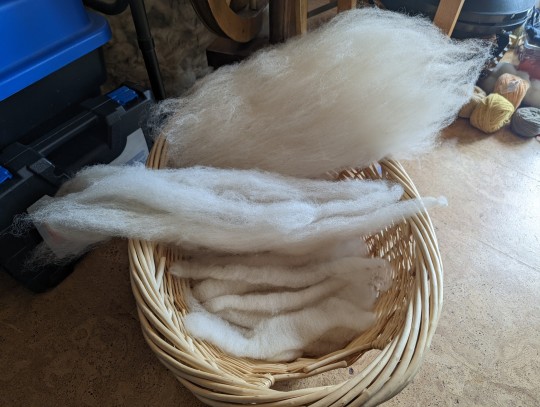
8 notes
·
View notes
Text
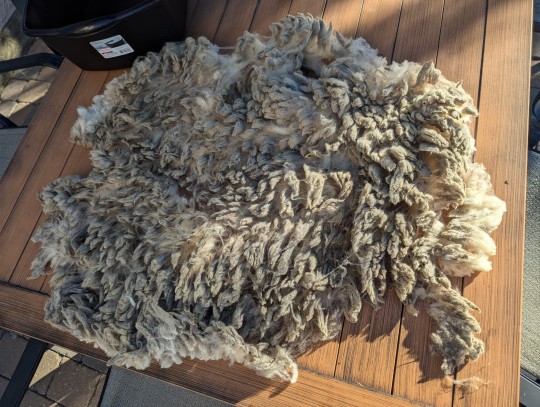
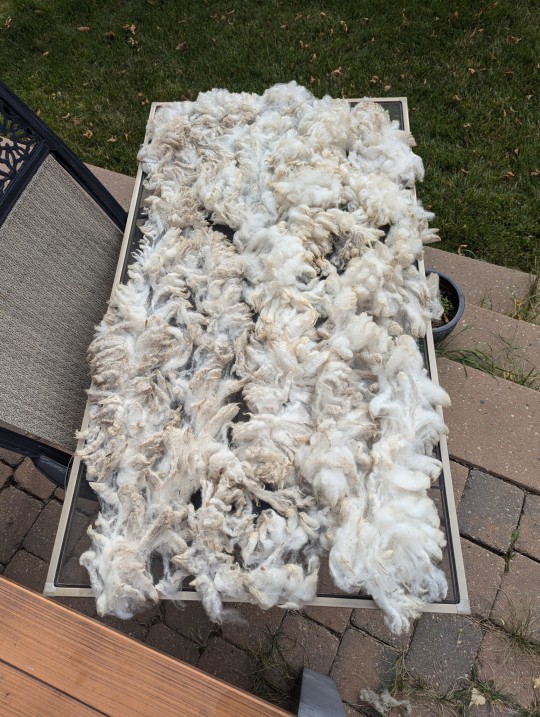


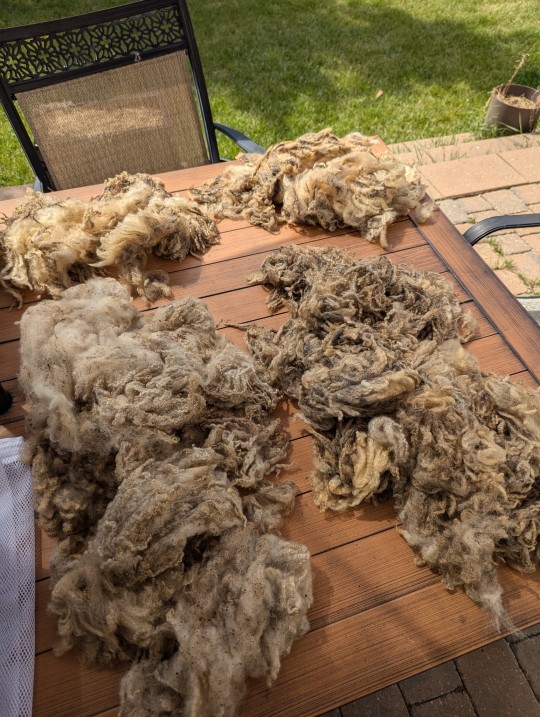

scouring fleece is so satisfying
top: corriedale x rambouillet
middle: corriedale x Cotswold x Lincoln x cvm
bottom: bfl
2 notes
·
View notes
Text
26-11-2023, part two:
I started the day with skirting the fleece. I removed very dirty and matted pieces, along with big pieces of vegetable matter, this was discarded.
I removed the dirty edges (belly, top of legs, neck), these I washed with dishwashing soap with the following method (by no means a tutorial, just what I did):
1. Fill the bucket with hot water (I made it so hot it was steaming, but I could (barely) put my hands in it), about 5 liters. Add dishwashing soap, I didn’t measure, but the water felt soapy (maybe 3-4 tablespoons?). Add the wool, let soak for 15 minutes, drain.
2. Repeat step 1, but with about half the soap.
3. Fill the bucket with hot water (a little less hot than step 1, but still hot), add the wool and let soak for 15 minutes, drain.
4. Repeat step 3. The water was not completely clear after this step, but that’s fine. I plan to dye this fiber, so I will soak it again before I do that. If you want to get it cleaner, you can soak one more time.
5. Squeeze as much water out of the wool as possible and spread on a drying rack. It will drip quite a bit at first, so I kept it outside for a few hours before letting it completely dry inside (1-ish day).
Note: The curls kept a lot of dirt in them and needed some agitation to get clean. Do not agitate the wool, it can felt! I gently rubbed the curls between my fingers while soaking, but even now as it’s drying I can see there is still some dirt stuck in them. Maybe an idea would be to open up the locks before scouring.
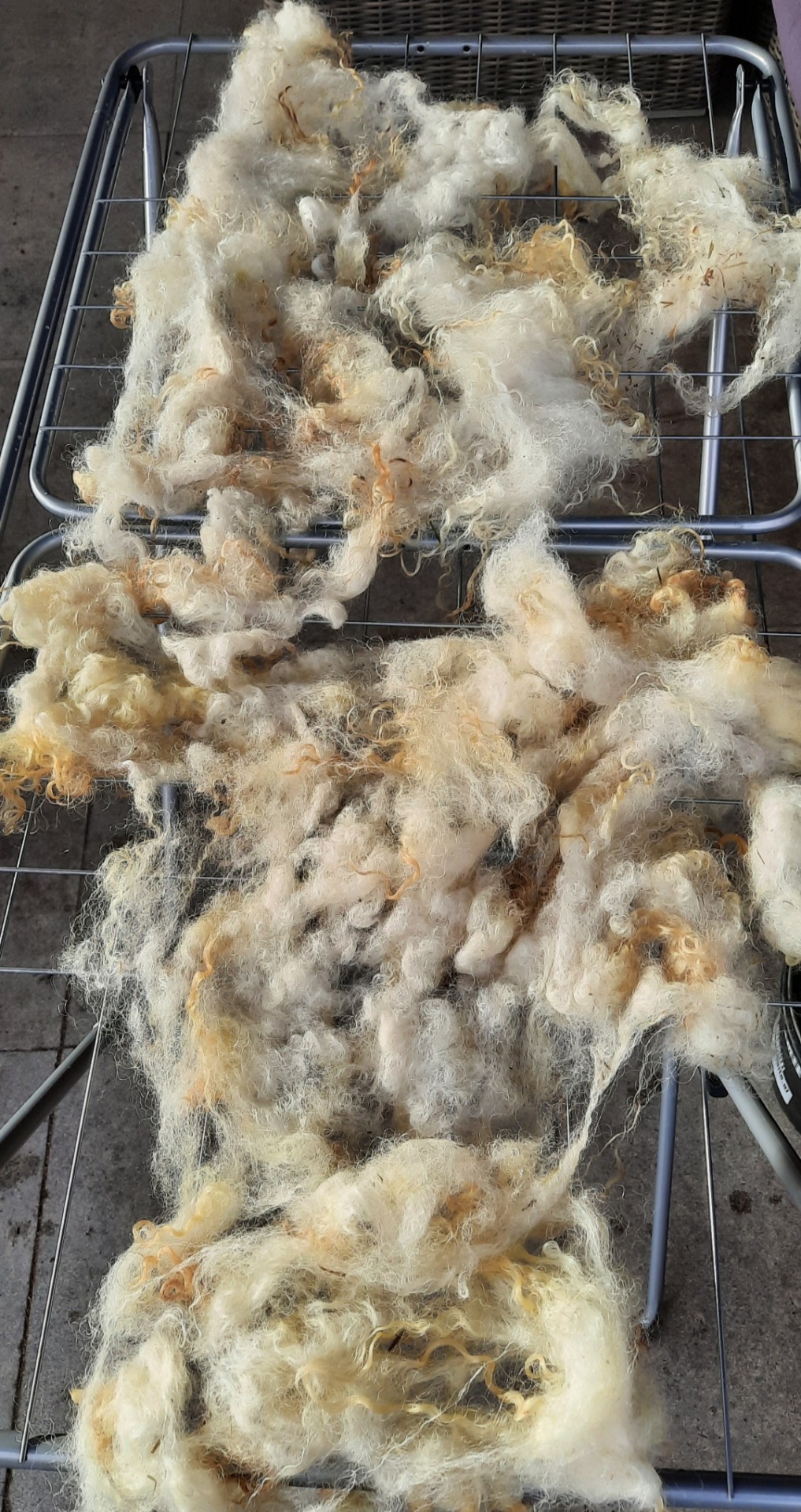
(This is wet, it looks less yellow when dry)
After drying, I weighted the wool. This came out to be about 150 grams. Unfortunately, I didn't weigh the fiber before washing. This I will keep in mind if I use this method of scouring again. All of the skirting and scouring took about two hours.
Here are some pictures of the dry, scoured, wool and the pretty curls! The wool looks less yellow in person, but that might also be the artificial lighting. I was at school all day today, so I will try to get better pictures tomorrow. Still,, look at that texture! Those curls!
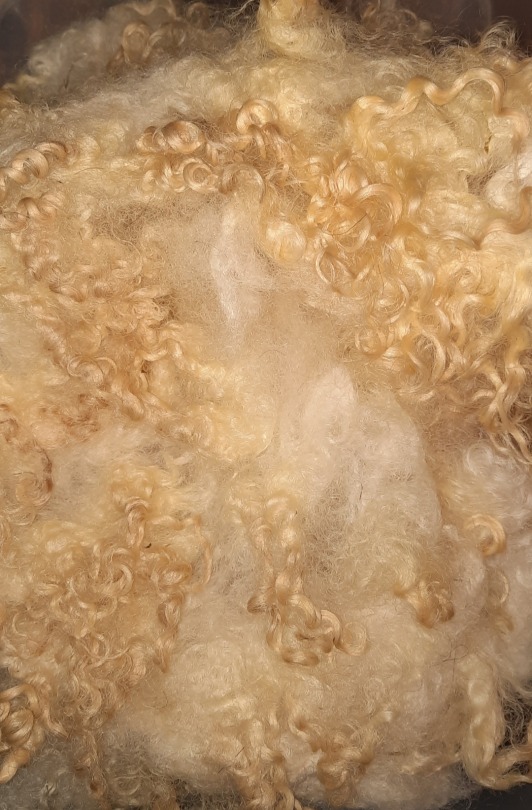
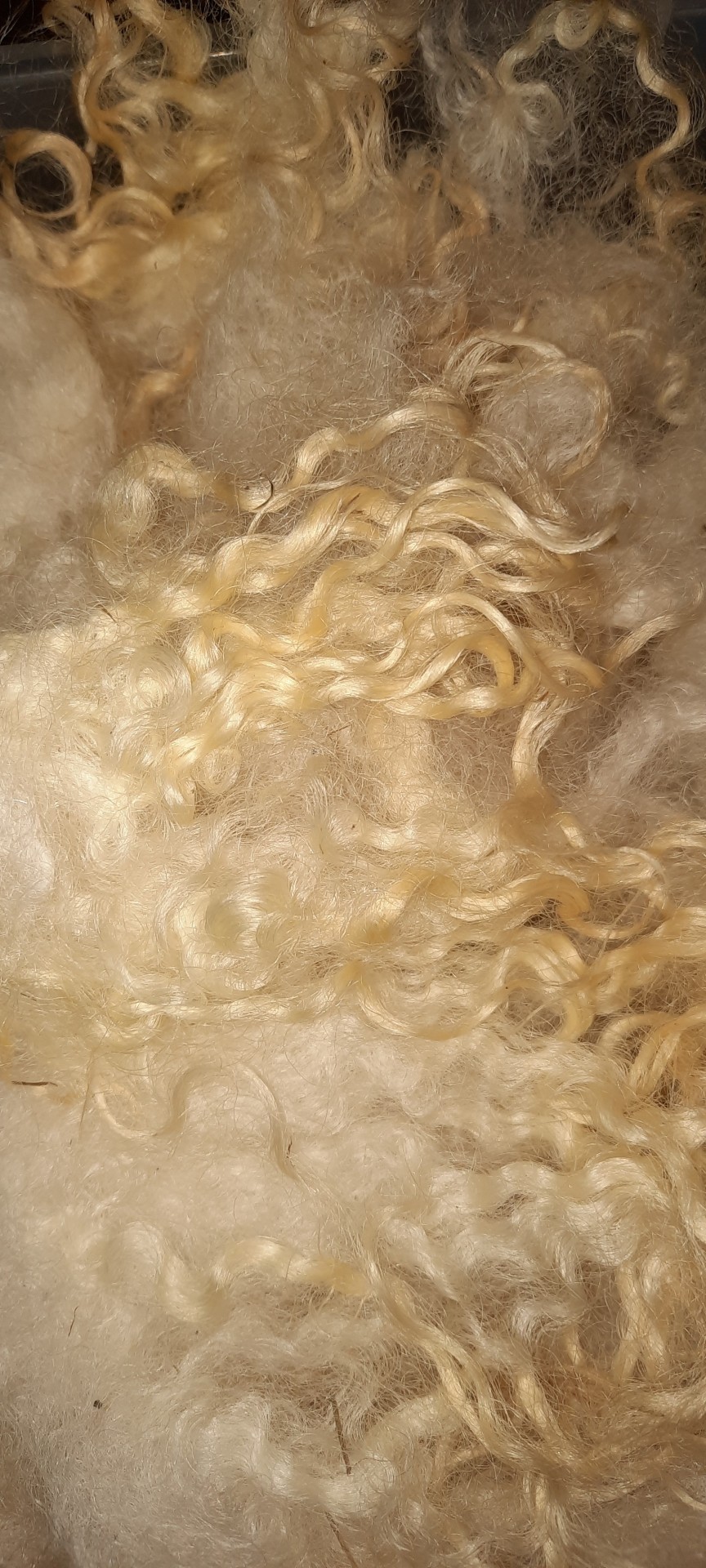
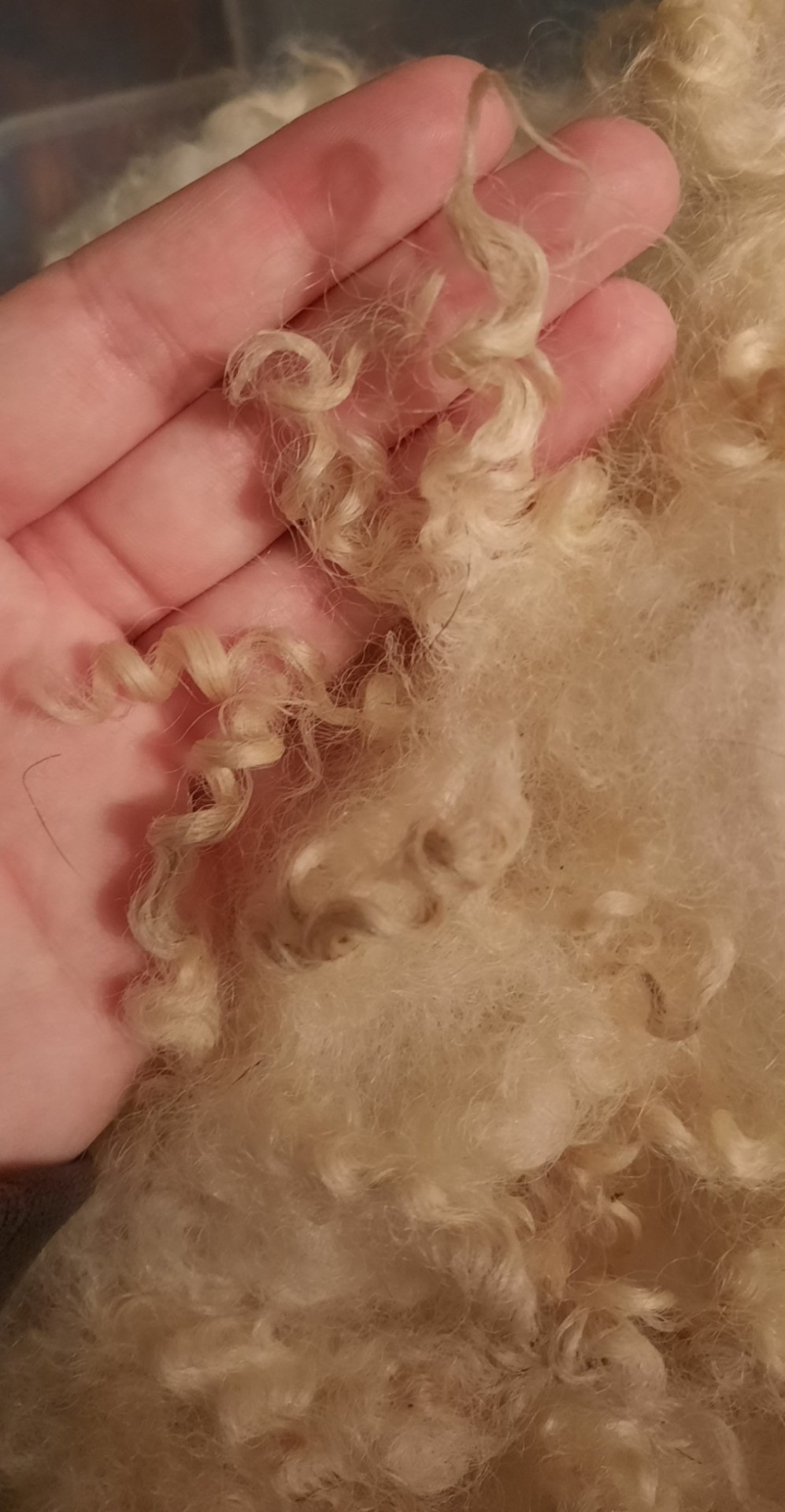
The wool is so lovely. It's very soft and white (with slightly yellow ends, but those will blend in when carded).
Plan for tomorrrow: Weigh out +-500 grams of the fleece to let soak in cold water overnight. This will remove dirt and some lanolin.
Overal plan: Card both fibers (scoured and soaked) in the weekend. Dye the scoured fiber. Do a test spin with the soaked fiber (sweather on needles 8-10), decide if I want to ply this with white alpaca or not.
Thanks for following along!
(Part one) (Part three)
#fiber crafts#fiber arts#fiber art#wool spinning#hand spinning#spinning#wool#sheep#slow fashion#from sheep to sweather#fleece#fleece processing#walliser schwarznase#scouring#work in progress#lights enlightenment
4 notes
·
View notes
Text
The bath itself:
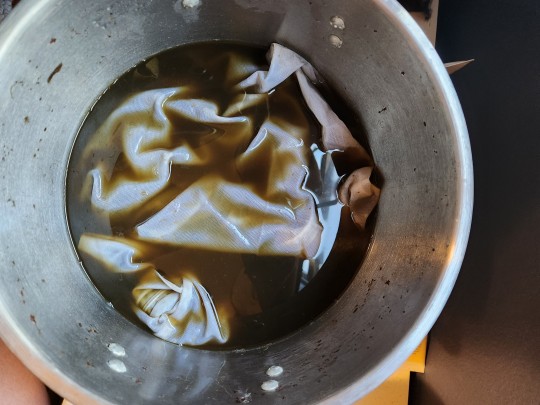
The fleece just taken out, pre-rinse (locks have been thoroughly picked prior to bath):
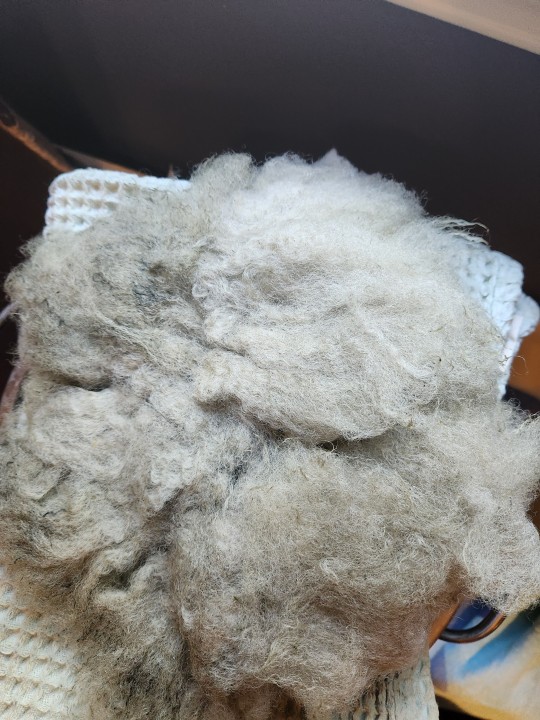
Raw locks next to freshly bathed/picked locks:
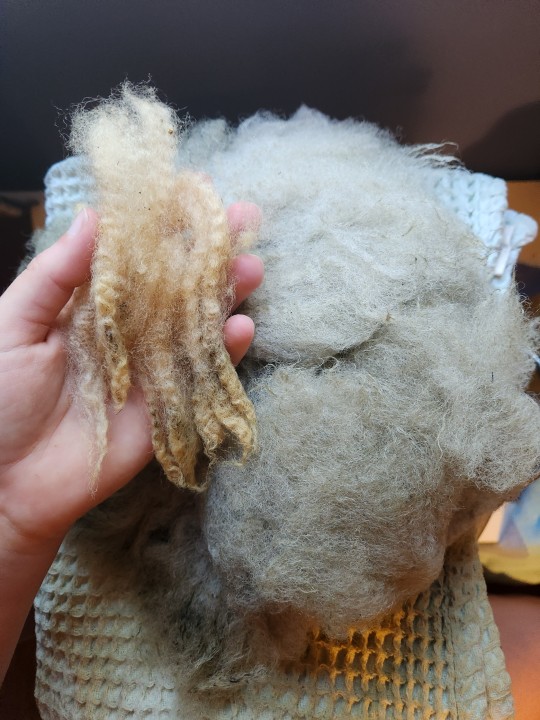
Picked locks next to washed picked locks:
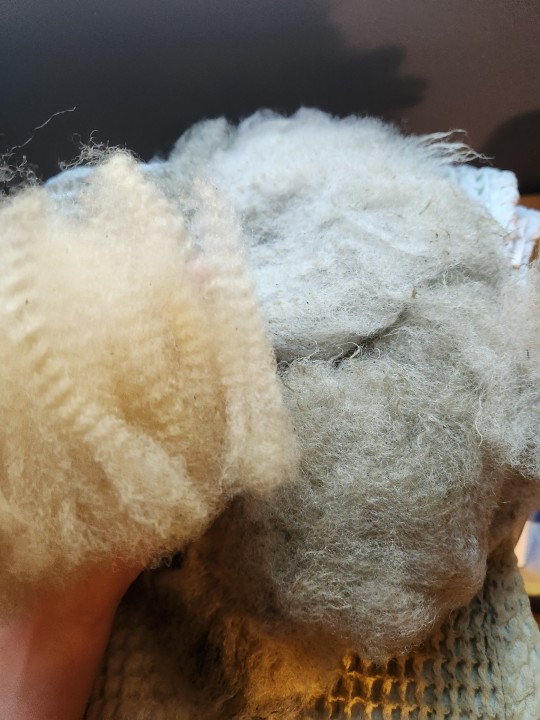
Rinsed & dried next to just taken from bath (note the lingering vm):
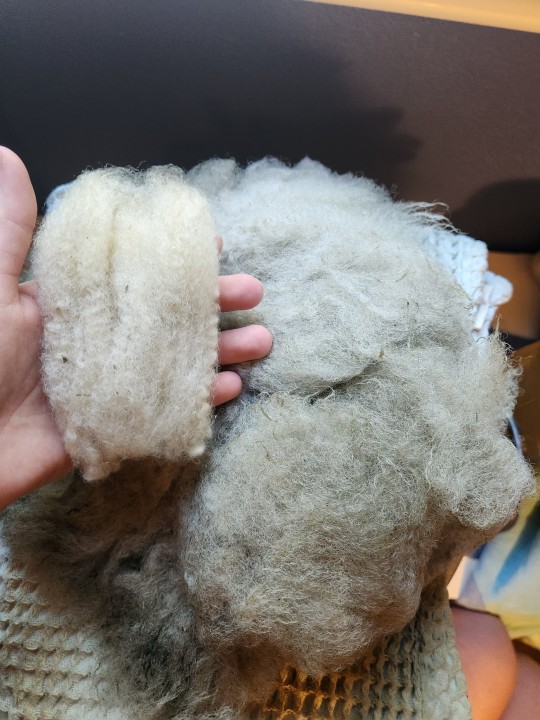
Aaand picked locks, washed/rinsed/picked, next to raw locks:
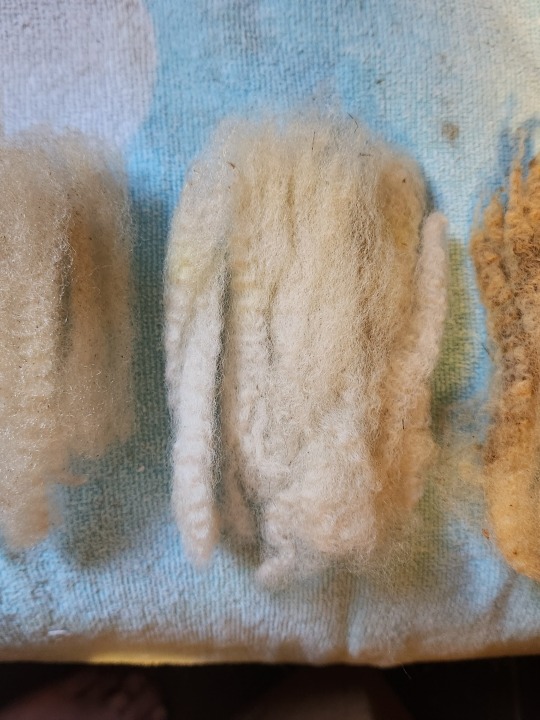
This is 1 week-ish in suint bath + 1 rinse in water, no non-suint soap or detergent involved! I am greatly impressed, even if the pictures don't show the dirt & grease as well as I'd like. I've been doing a mesh bag worth a week, or thereabouts, currently have 3.5 full bags of clean dry locks and a LOT more raw left XD
Bonus: the rinse water:
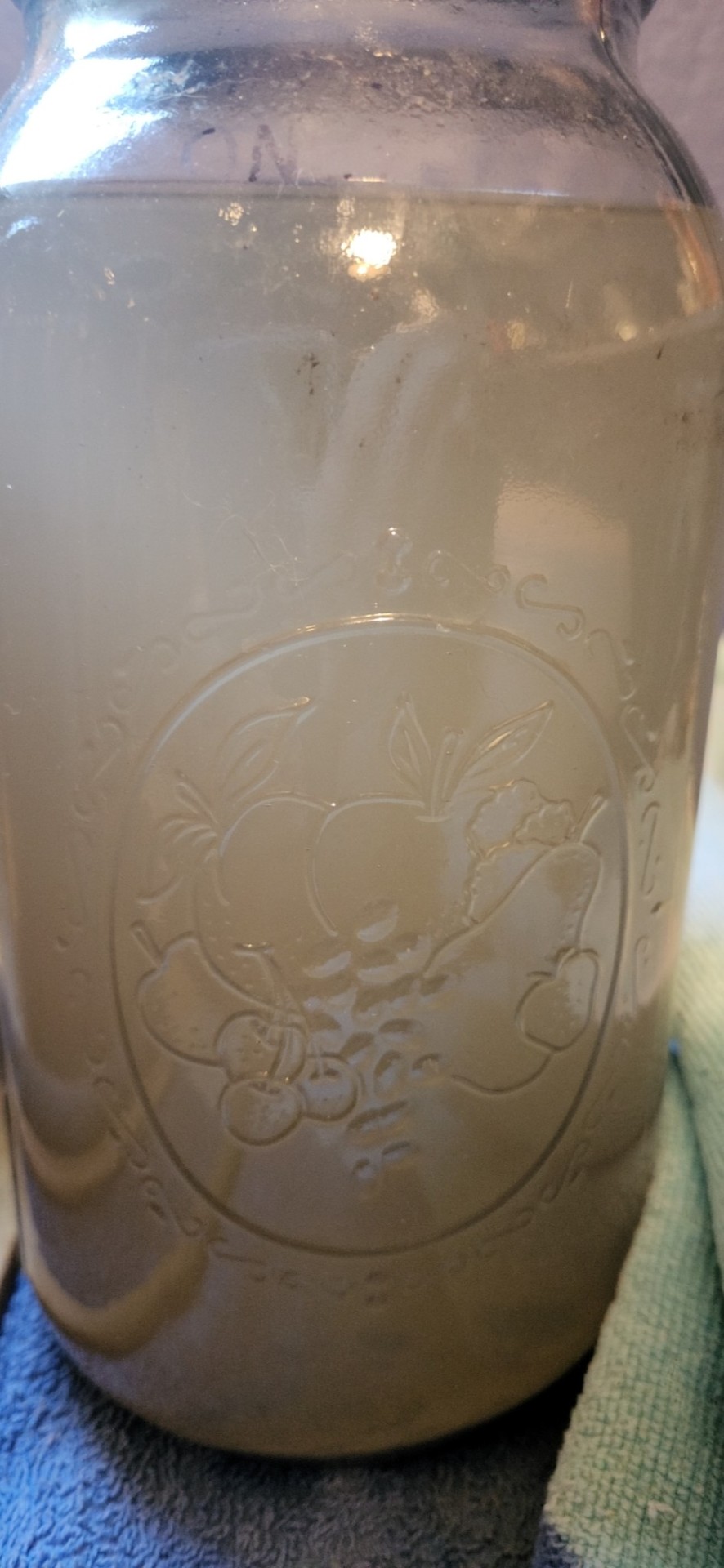
0 notes
Text
The goat fleece is funny. I thought the Bishops would acknowledge a new crown bearing caprine randomly showing up in place of the lamb that killed them but nope, they never make any mention of the goat (as far as I'm aware). Those guys just go along with it lol.
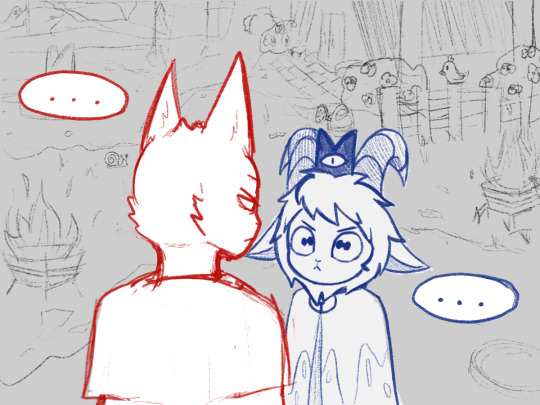
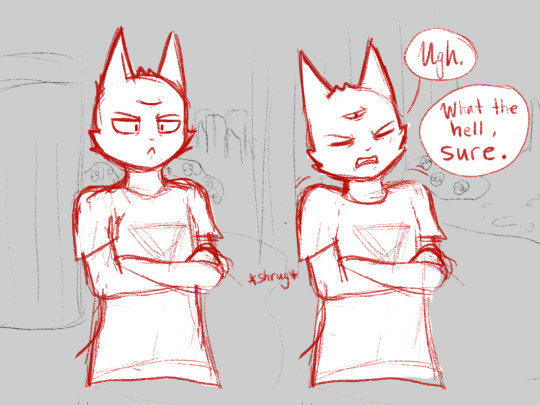

#cult of the lamb#my post#gif#cotl goat#cotl narinder#cotl fanart#narigoat#narilamb#idk if I should tag that but when I was drawing these my thought process was that goat is just the lamb wearing the goats skin bc they have#the fleece on#so not the actual goat if that makes any sense#just a halloween costume#but narinder doesn't know that#he cheats on me every save file idk what to do because its always with my favorite followers who I don't wanna kill#cheating tw#infidelity tw
209 notes
·
View notes
Text
Sheep are dirty. This is a relatively clean fleece (well skirted, no vm) and I removed the tips, and it's still nasty

Thankfully it's easy to clean, and now I've got some beautiful white locks that will be combed once they're dry.
23 notes
·
View notes
Text

Fleece of the Diseased Heart
#my art#cotl#cotl lamb#no thought process for this one just Vibes#i dont care for the effects of this fleece but i do like the way it looks :]
204 notes
·
View notes
Text
When you get to a point in fiber arts where you start wanting to learn other crafts just so that you can better make what you're making, that's when you know you're screwed
I keep eyeing inkle looms because I need to make woven straps for the handspun crochet bags I keep making and the knit icord strap is so annoying to make. And I will never know peace until I can make the Perfect Bags.


#this is how i got int9 fleece processing too#wanted to make something iron age but knew commerciap roving would be a shit substitute fot hand prepped fiber#spinning#knitting#handspun yarn#weaving#inkle loom#crochet#q
186 notes
·
View notes
Text
I have learned to diz! Batt has been made into roving.
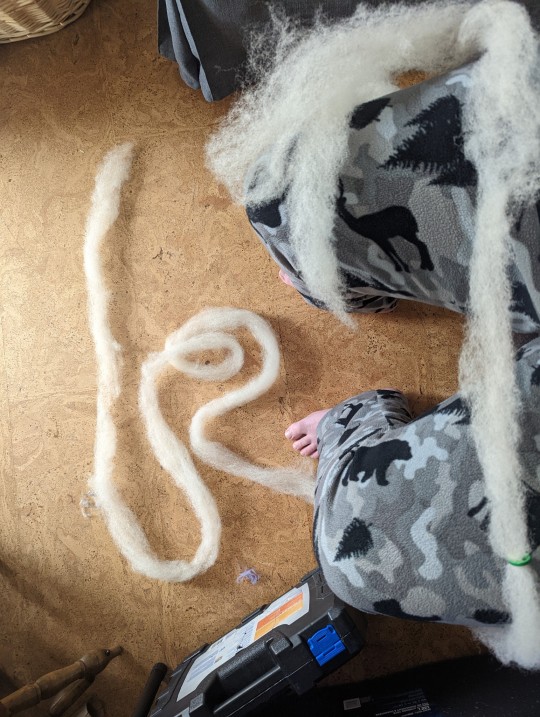
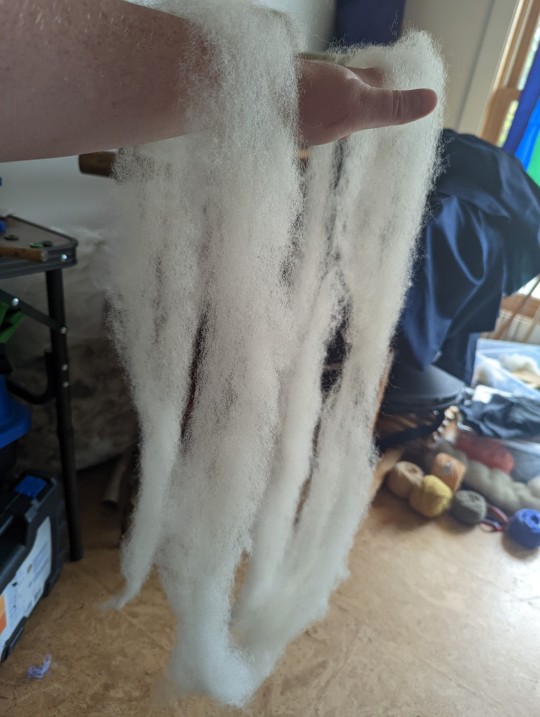
I used buttons.
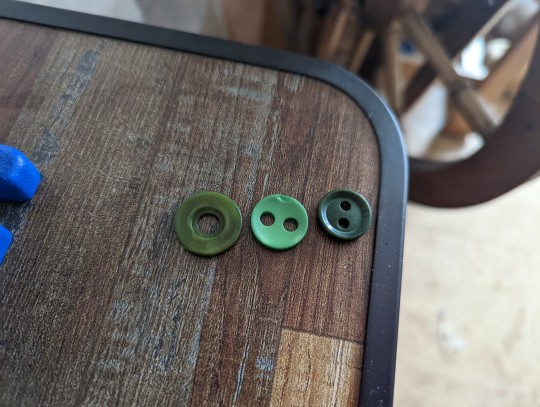
2 notes
·
View notes
Text
I'm not doing tdf this year HOWEVER in exciting fiber news I have wool combs now! I don't have good pictures due to poor light quality but the Hebridean fleece I bought last year is combing out into beautiful, soft, springy nests.
That being said, the waste is really hard to deal with. I kind of want to see what would happen if I put it through my drum carder since there's a lot of decent length fibres there. And hey, if it doesn't work out, I have a lot I can gift to my friend for needle felting purposes!
9 notes
·
View notes
Text
27 & 28 -11-2023, part three:
I took about 400 grams of the fleece to do a test spin with, I took this from either the neck or the butt area (no idea which side haha).
I filled a large bucket/tub thing with cold water (25 liters?) and soaked the fleece overnight. I put the bucket in the shed to protect it from snow and animals, but also to protect my house from the smell.
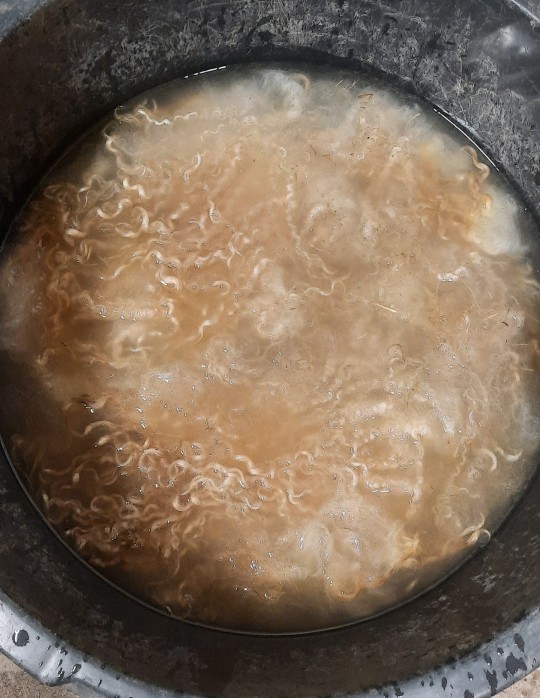
Fleece has a lot of dirt, lanolin and suint in it. Suint is dried sweat from the sheep. It is soluble in cold water and acts as a natural soap (it contains potassium salts and soapy organic acids). When soaking the fleece in cold water over night, it dissolves and acts as a cleansing agent, removing dirt and some of the lanolin. This method does not work for very dirty or greasy fleeces, then it might be better to scour with soap. If you want to dye the fiber, you will also want to remove more (if not all) the lanolin. I will check if this soak was enough for my preferences after the wool dries. Otherwise, I will scour it with dishwashing soap. (Waltin, 2019 & McCune, 2022)
In the summer, I would like to experiment with fermenting a piece of fleece. This method also uses the suint to clean the fleece, only you let it ferment for a week or longer. (This smells a lot though, so I'll have to convince my parents hah)
After the fleece soaked overnight, I rinsed it twice with cold water (letting it soak +-10 minutes each time) and squeezed as much of the water out as possible. Then I spread it out on a drying rack. It is currently drying, I expect it to take 2-3 days to dry fully. This should be in time for me to card it in the weekend.
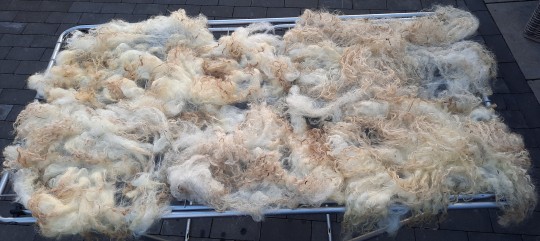
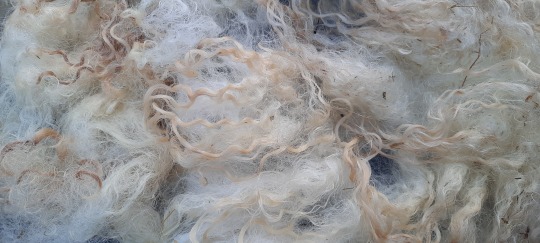
While it looks cleaner than the unwashed fleece, it is not as clean as the scoured wool (which I forgot to take better pictures of...). While spinning I will decide which way I find nicer, in the grease or not. I will then wash/scour the rest of the fleece accordingly.
This wool I want to use for some test spins and swatches, to find out the following:
Combine with alpaca or not
2 or 3 ply (If 2 ply, 100% wool or 50/50 wool/alpaca; if 3 ply, chain ply or 3 wool or with 2 wool 1 alpaca)
Spinning thickness (needle 10, thick but drapey fabirc)
Possibly only adding alpaca in the cuffs and neck? (to lessen the itchiness)
Thanks for following along!
(Part one) (Previous part) (Part four)
(Waltin, J. (2019, June 15). Washing fleece. Josefin Waltin Spinner. Retrieved November 28, 2023, from https://waltin.se/josefinwaltinspinner/washing-fleece/)
(McCune, K. (2022, July 10). How Do You Wash Wool In A Suint Bath? Woolmaven.com. Retrieved November 28, 2023, from https://woolmaven.com/673/how-do-you-wash-wool-in-a-suint-bath/)
#fiber art#fiber crafts#wool spinning#wool#spinning#handspinning#from sheep to sweater#fleece processing#fleece#wool sweater#hand spinning#fiber#work in progress#fiber arts#textile arts#sheep#walliser schwarznase#valais blacknose#valais blacknose sheep#suint washing#suint fermenting#lights enlightenment
1 note
·
View note
Text

The Lady Godiva Procession of 1829, Coventry
Artist: David Gee (English, 1793–1872)
Date: 1861
Medium: Oil on canvas
Collection: Herbert Art Gallery & Museum, Coventry, England
Description
The Godiva Procession is an annual procession in the city of Coventry, England, which re-enacts the story of Lady Godiva. Godiva Processions have been held in Coventry since the 17th century.
The scale of the procession grew in the following years, and by 1829, the programme describes the order of the procession: led by city guards, St George, bugles and city banners, then Lady Godiva, followed by the civic leaders and staff, numerous bands, Companies such as carpenters and blacksmiths, each with their own banners and followers, then the many Benefit Societies, with their bands and followers. Towards the rear came Woolcombers representing the wool trade in the city, together with the mythical Jason with his Golden Fleece and drawn sword.
#historical narrative#godiva procession#gate#architecture#city guards#st george#city banners#lady gociva#civic leaders#horse#carpenters#blacksmiths#mythical jason#golden fleece#drawn sword#men#women#children#historical representation#history painting#oil on canvas#fine art#oil painting#artwork#painting#english culture#english art#david gee#english painter#european art
8 notes
·
View notes
Text
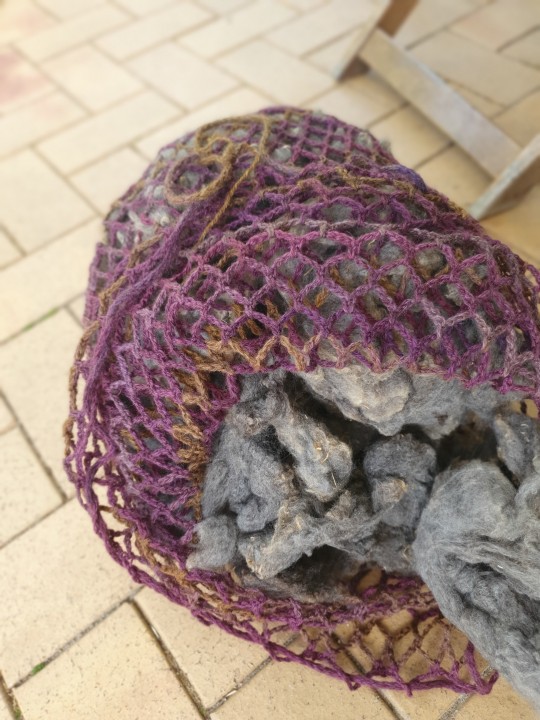
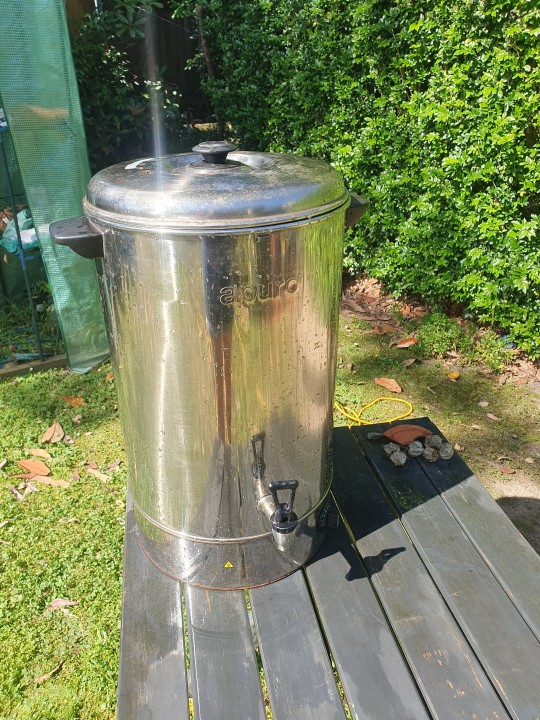
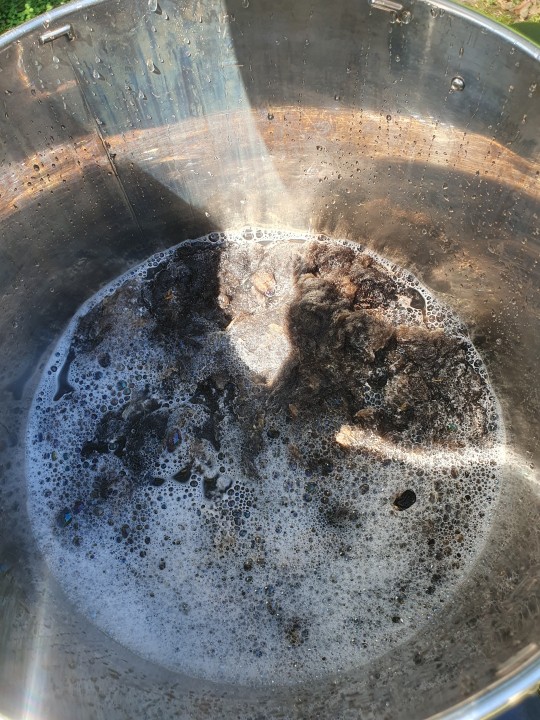
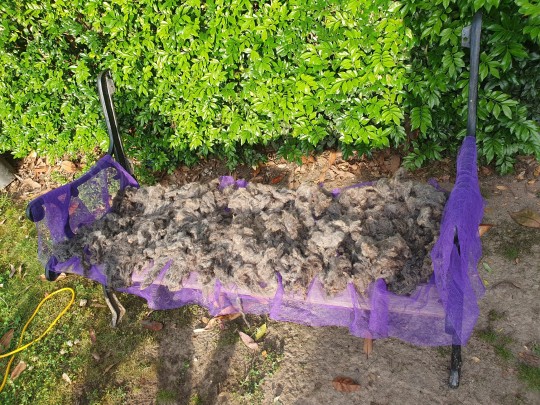
More adventures in fleece washing with the urn!
Rewashed this merino cross fleece, it was still so greasy and a bit yucky. Got it to about 85 degrees for a good soapy wash, it's a lot nicer.
It also dried in an afternoon, thank you hot sunny weather!
Lot of vm in this one relative to the moorit, so more emphasis will be on picking it outside.
#craft#craftblr#wool#spinning#fleece#fibre crafts#processing wool#washing wool#crafting outdoors#merino
18 notes
·
View notes
Text
^ not finished process current sheep fleece n already want more
29 notes
·
View notes
Text
Today my ardent hope is to finish filling this bobbin
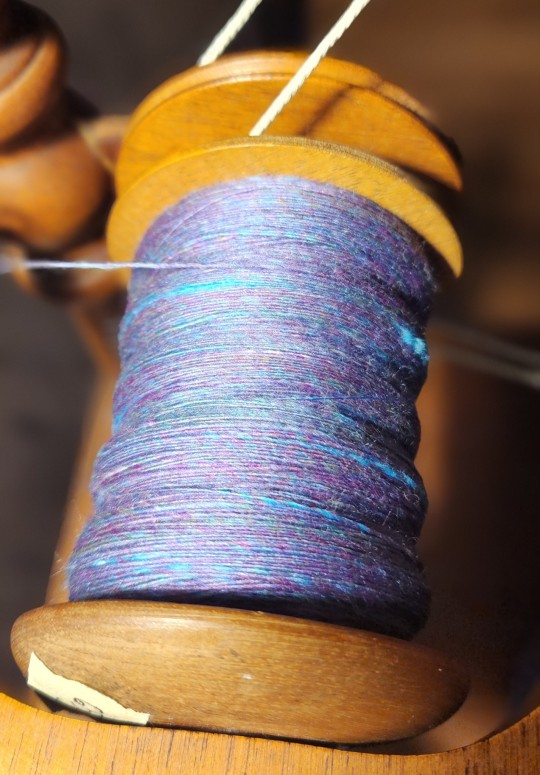
My goal is to attempt to get my handspun in some local shops and TDF is a great time to test my mettle at the wheel.
Has anyone managed to get their handspun in stores? How did it go for you?
#I've managed to get some finished items in stores before but my anxiety got the better of me and I ran away from continuing#currently in the process of looking into making yarn bands for my skiens#just need to find a print shop that understands what my goal is here#handspun#handspinning#craftblr#tdf 2024#tdf#tour de fleece#tdf day 6
25 notes
·
View notes